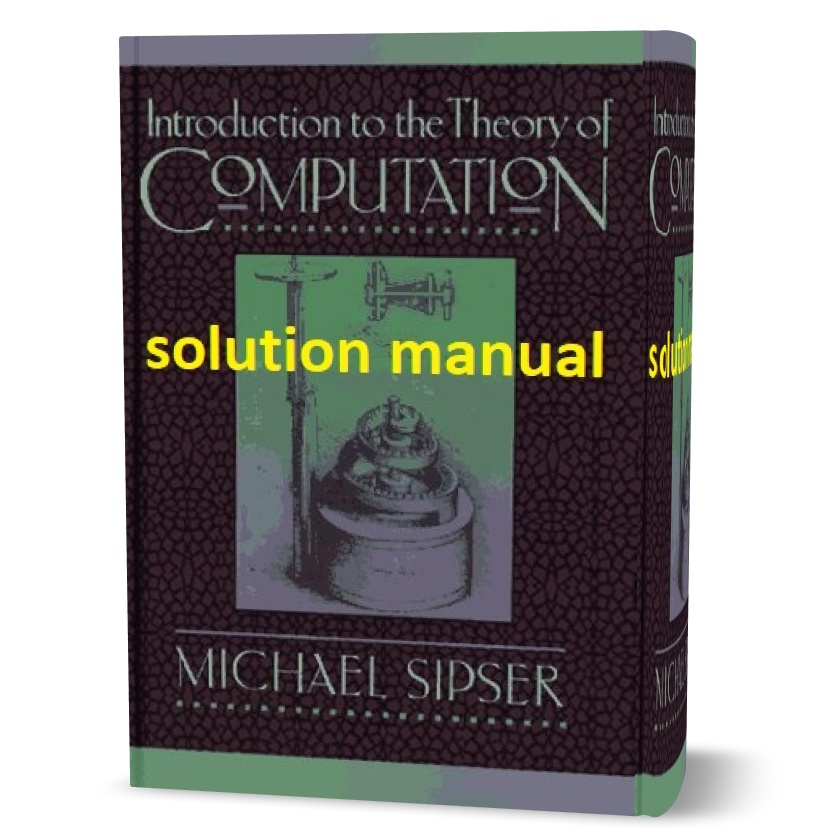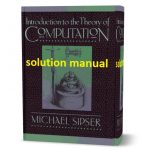introduction to the theory of computation Michael Sipser 1st edition solutions manual pdf
Original price was: $20.00.$5.00Current price is: $5.00.
Published: Itps Thomson Learning 1996
Edition: 1st
Pages: 62
Type: pdf
Size: 16MB
Content: Chapters 0 to 7 all problem answers
Sample: solution sample file
Download After Payment
- Description
- Reviews (0)
Description
Description
Theory is Download free introduction to the theory of computation michael sipser 1st edition solutions manual pdf | all chapter exercise solution relevant to practice. It provides conceptual tools that practitioners use in computer engineering. Designing a new programming language for a specialized application? What you learned about grammars in this course comes in handy. Dealing with string searching and pattern matching? Remember finite automata and regular expressions. Confronted with a problem that seems to re-quire more computer time than you can afford? Think back to what you learned about NY-completeness. Various application areas, such as modern cryptographic protocols, rely on theoretical principles that you will learn here. for download solutions manual click here.
introduction to the theory of computation michael sipser 1st edition solutions manual pdf
Theory also is relevant to you because it shows you a new, simpler, and more elegant side of computers, which we normally consider to be complicated ma-chines. The best computer designs and applications are conceived with elegance in mind. A theoretical course can heighten your aesthetic sense and help you build more beautiful systems. Finally, theory is good for you because studying it expands your mind. Computer technology changes quickly. Specific technical knowledge, though useful today, becomes outdated in just a few years. Consider instead the abilities to think, to express yourself clearly and precisely, to solve problems, and to know when you haven’t solved a problem. These abilities have lasting value. Studying theory trains you in these areas. Practical considerations aside, nearly everyone working with computers is curious about these amazing creations, their capabilities, and their limitations. A whole new branch of mathematics has grown up in the past 30 years to answer certain basic questions. Here’s a big one that remains unsolved: If I give you a large number, say, with 500 digits, can you find its factors (the numbers that di-vide it evenly), in a reasonable amount of time? Even using a supercomputer, no one presently knows how to do that in all cases within the *time of the universe! The factoring problem is connected to certain secret codes in modern cryptosystems. Find a fast way to factor and fame is yours!
TO THE EDUCATOR
This book is Download free introduction to the theory of computation michael sipser 1st edition solutions manual pdf | all chapter exercise solution intended as an upper-level undergraduate or introductory graduate text in computer science theory. It contains a mathematical treatment of the subject, designed around theorems and proofs. I have made some effort to accommodate students with little prior experience in proving theorems, though more experienced students will have an easier time. My primary goal in presenting the material has been to make it clear and interesting. In so doing, I have emphasized intuition and “the big picture” in the subject over some lower level details. For example, even though I present the method of proof by induction in Chapter 0 along with other mathematical preliminaries, it doesn’t play an important role subsequently.
Generally I do not present the usual induction proofs of the correctness of various constructions concerning automata. If presented clearly, these constructions convince and do not need further argument. An in-duction may confuse rather than enlighten because induction itself is a rather sophisticated technique that many find mysterious. Belaboring the obvious with an induction risks teaching students that mathematical proof is a formal manipulation instead of teaching them what is and what is not a cogent argument.
A second example occurs in Parts Two and Three
where I describe Download free introduction to the theory of computation michael sipser 1st edition solutions manual pdf | all chapter exercise solution algorithms in prose instead of pseudocode. I don’t spend much time programming Turing machines (or any other formal model). Students today come with a programming background and find the Church—Turing thesis to be self-evident. Hence I don’t present lengthy simulations of one model by another to establish their equivalence. Besides giving extra intuition and suppressing some details, I give what might be called a classical presentation of the subject material. Most theorists will find the choice of material, terminology, and order of presentation consistent with that of other widely used textbooks.
I have introduced original terminology in only a few places, when I found the standard terminology particularly obscure or confusing. For example I introduce the term mapping reducibility instead of many—one reducibility. Practice through solving problems is essential to learning any mathematical subject. In this book, the problems are organized into two main categories called Exercises and Problems. The Exercises review definitions and concepts. The Problems require some ingenuity. Problems marked with a star are more difficult. I have tried to make both the Exercises and Problems interesting challenges.




Reviews
There are no reviews yet.